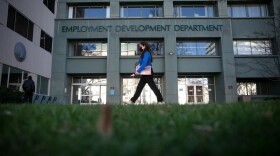Up until this week, the San Diego Police Department has broadcast police calls on an open channel. It’s been a resource for people who follow crime and monitor the police. But some say it has its drawbacks.
“In the past we were not encrypted, which meant that by using police scanners anyone in the public, the media, etc. could listen in on all of our radio communications,” said San Diego Police Lt. Daniel Meyer. “And as you know when it comes to 911 calls and the information that’s conveyed from our dispatch center to our officers, we’re conveying sensitive information.”
By encrypting those messages San Diego police are following a national and statewide trend that is making personally owned scanners go silent. A 2020 mandate by the California Department of Justice ordered all police departments to carry out the encryption.
The San Francisco Police Department finished encrypting their calls in 2021. The San Diego Sheriff’s Department started encrypting in 2022, and several other police departments in the region, Chula Vista and Escondido to name a couple, have also done it.
Meyer said SDPD came late to the party because they needed to upgrade thousands of squad car radios and hand-held radios in order to do it.
The “sensitive information” he said is going out over the air is information about crime victims that could violate their privacy.
“Whether it be dates of birth, addresses, phone numbers, names of victims of crimes. So that’s the intent of the Department of Justice (in ordering encryption),” Meyer said.
But there’s another side to the argument that comes from people who believe the public should be able to know what the police are up to.
“Law enforcement agencies are using this concern about people’s privacy to withdraw a variety of information that’s really the bread and butter of how people know about — not just what police do in their communities but also active emergency situations,” said Aaron Mackey, one of the litigation directors with the Electronic Frontier Foundation (EFF).
Mackey points out police scanners have long been a valuable resource for the media who cover crime and other emergencies. Monitoring police communications can inform the public of dangerous situations in their neighborhoods, whether it’s a shooting or a wildfire.
Mackey said the possibility of broadcasting personal information needs to be weighed against that. He adds that alternatives already exist in many departments, including the selective use of existing channels that are already encrypted.
“And those are used for legitimate reasons like, you don’t want the person in some violent situation to know exactly where police are positioning themselves or how they are trying to evacuate bystanders,” he said.
SDPD’s Meyer said they are trying to imagine different ways to make information available, as they also comply with the Justice Department mandate.
“We have a new website which is our ‘dispatch portal’ that media and the public can go to, to see what’s going on within the city,” Meyer said. “Now, we’re not as satisfied as we would like to be in this changeover with what the portal provides. We’re looking to make that a little more robust and a little more current.”
SDPD told The San Diego Union-Tribune that nearly all law enforcement agencies in Southern California have adopted encrypted radio technology to meet Justice Department standards.






